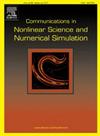脉冲调幅对Duffing系统弛豫振荡的影响
IF 3.4
2区 数学
Q1 MATHEMATICS, APPLIED
Communications in Nonlinear Science and Numerical Simulation
Pub Date : 2025-01-14
DOI:10.1016/j.cnsns.2025.108606
引用次数: 0
摘要
本文报道了脉冲幅度调制(PAM)引起的快慢动力学。通常,PAM通过改变脉冲信号的幅度来传输信息信号,其核心概念是脉冲序列的幅度会随着输入数据的变化而变化。观察到在Duffing系统中引入额外的脉冲激励会导致以突变跳变为特征的松弛振荡模式。利用快慢分析方法,阐明了这些弛豫振荡的产生机理,其中PAM是由周期余弦信号和周期脉冲信号叠加产生的。随后,分别讨论了周期余弦激励、脉冲激励和单慢变量PAM激励的情况。研究表明,PAM在Duffing系统的快慢动力学中起着至关重要的作用。具体来说,脉冲调制下振幅的变化导致不同程度的弛豫振荡模式。例如,低PAM诱导了一种模式,在这种模式中,由灾难性跳跃连接的传统振荡与静息状态交替发生。此外,当振幅超过某个临界值时,它会导致由突变跳变连接的弛豫振荡与静息状态交替的模式。此外,当调制幅值超过另一个临界值时,它会引起静息状态位置的转变,这与不同幅值的吸引域有关。基于这些发现,揭示了复合弛豫振荡模式。最后通过电路仿真实验的对比验证了结果的正确性。本文章由计算机程序翻译,如有差异,请以英文原文为准。
Effects of pulse amplitude modulation on relaxation oscillations in the Duffing system
This paper reports on the fast-slow dynamics induced by pulse amplitude modulation (PAM). Typically, PAM transmits information signals by altering the amplitude of the pulse signal, with the core concept being that the amplitude of the pulse sequence varies according to the input data. It was observed that introducing additional pulse excitation in the Duffing system results in a relaxation oscillation mode characterized by catastrophic jumps. Using the fast-slow analysis method, the generation mechanism of these relaxation oscillations was elucidated, wherein PAM results from the superposition of periodic cosine and periodic pulse signals. Subsequently, the cases of periodic cosine excitation, pulse excitation, and PAM excitation for a single slow variable were separately discussed. The study demonstrates that PAM plays a critical role in the fast-slow dynamics of the Duffing system. Specifically, changes in amplitude under pulse modulation lead to varying degrees of relaxation oscillation modes. For instance, low PAM induces a mode where conventional oscillations connected by catastrophic jumps alternate with a resting state. Moreover, when the amplitude crosses a certain critical value, it leads to a mode where relaxation oscillations connected by catastrophic jumps alternate with a resting state. Furthermore, when the modulation amplitude exceeds another critical value, it causes a transition in the resting state position, which is associated with the attraction domains at different amplitudes. Based on these findings, compound relaxation oscillation modes were revealed. Finally, comparisons of circuit simulation experiments validated the results.
求助全文
通过发布文献求助,成功后即可免费获取论文全文。
去求助
来源期刊

Communications in Nonlinear Science and Numerical Simulation
MATHEMATICS, APPLIED-MATHEMATICS, INTERDISCIPLINARY APPLICATIONS
CiteScore
6.80
自引率
7.70%
发文量
378
审稿时长
78 days
期刊介绍:
The journal publishes original research findings on experimental observation, mathematical modeling, theoretical analysis and numerical simulation, for more accurate description, better prediction or novel application, of nonlinear phenomena in science and engineering. It offers a venue for researchers to make rapid exchange of ideas and techniques in nonlinear science and complexity.
The submission of manuscripts with cross-disciplinary approaches in nonlinear science and complexity is particularly encouraged.
Topics of interest:
Nonlinear differential or delay equations, Lie group analysis and asymptotic methods, Discontinuous systems, Fractals, Fractional calculus and dynamics, Nonlinear effects in quantum mechanics, Nonlinear stochastic processes, Experimental nonlinear science, Time-series and signal analysis, Computational methods and simulations in nonlinear science and engineering, Control of dynamical systems, Synchronization, Lyapunov analysis, High-dimensional chaos and turbulence, Chaos in Hamiltonian systems, Integrable systems and solitons, Collective behavior in many-body systems, Biological physics and networks, Nonlinear mechanical systems, Complex systems and complexity.
No length limitation for contributions is set, but only concisely written manuscripts are published. Brief papers are published on the basis of Rapid Communications. Discussions of previously published papers are welcome.
 求助内容:
求助内容: 应助结果提醒方式:
应助结果提醒方式:


